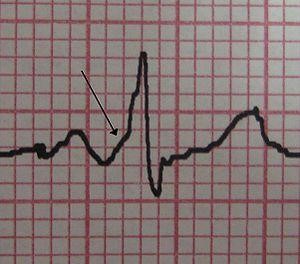Wolff Parkinson White Flashcard
Rationale
A. Rationale: Electrophysiologic studies have mapped the accessory pathway in patients with Wolff-Parkinson-White syndrome and found that 50% have accessory pathways in the left lateral area.
Answer choice B – 30% are located in the posteroseptal area.
Answer choice C – 10% are located in the right anteroseptal area.
Answer choice D – 10% are located in the right lateral area of the atrioventricular ring.
Question
In patients with Wolff-Parkinson-White syndrome, the accessory pathway lays in any of the regions of the atrioventricular ring or the septum. Which one of the following regions is the most common location in these patients?
a. Left lateral
b. Posteroseptal
c. Right anteroseptal
d. Right lateral
Answer
a. Left lateral
Rationale
A. Rationale: The arrow points to a slurred R wave, which is indicative of an accessory pathway seen in patients with Wolff-Parkinson-White syndrome. This slurred R wave is also called a delta wave.
Answer choice B – A right bundle branch block would manifest as a QRS complex wider than 0.12 seconds with an RSR pattern in lead VI.
Answer choice C – A left bundle branch block would manifest as a QRS complex wider than 0.12 seconds with a dominant S wave in lead VI.
Answer choice D – Wenckebach phenomenon is a type of heart block in which the PR interval lengthens prior to dropping a QRS complex. This occurs because the action potential fails to conduct the ventricles.
Question
This QRS complex configuration is commonly seen in which of the following diseases of abnormal heart conduction?

a. Wolff-Parkinson-White syndrome
b. Right bundle branch block
c. Left bundle branch block
d. Wenckebach phenomenon
Answer
a. Wolff-Parkinson-White syndrome
Rationale
A. Rationale: Verapamil and digitalis drugs are contraindicated in patients with Wolff-Parkinson-White syndrome, especially with concomitant atrial fibrillation, because they suppress the normal conduction through the AV node. When this is blocked, the conduction along the accessory pathway is unhindered. The net effect is worsening of the arrhythmia.
Answer choice B – Acetaminophen is a class of analgesics/antipyretics that has no effect on conduction through the AV node.
Answer choice C – Lisinopril is an angiotensin-converting enzyme inhibitor that prevents the conversion of angiotensin I to angiotensin II and eventually aldosterone. This results in relaxation of the peripheral vessels, leading to a decrease in afterload and blood pressure. This drug has no effect on conduction through the AV node.
Answer choice D – Amiodarone is the pharmacologic treatment for Wolff-Parkinson-White syndrome. It suppresses the orthodromic atrioventricular reentrant tachycardia, prolongs repolarization, blocks fast sodium and slow calcium channels, and suppresses ectopic beats.
Question
Which of the following drugs is contraindicated in Wolff-Parkinson-White syndrome because it tends to suppress normal conduction in the atrioventricular node?
a. Verapamil
b. Acetaminophen
c. Lisinopril
d. Amiodarone
Answer
a. Verapamil
Rationale
A. Rationale: Wolff-Parkinson-White syndrome has a short delta wave pattern followed by a prolonged and distorted QRS complex. The PR interval is short (< 120 ms).
Answer choice B – ST segment elevation is seen in patients with myocardial infarction.
Answer choice C – Prolonged PR intervals can be seen in patients with atrioventricular blocks.
Answer choice D – Irregular wide QRS complexes with varying amplitudes that have a twisting pattern along in the isoelectric line is indicative of torsades de pointes.
Question
Which of the following ECG characteristics is commonly seen in patients with Wolff-Parkinson-White syndrome?
a. Delta wave pattern followed by a prolonged distorted QRS complex
b. ST segment elevation
c. Prolonged PR interval followed by a pause
d. Irregular QRS complex with different amplitudes that twists along the isoelectric line
Answer
a. Delta wave pattern followed by a prolonged distorted QRS complex